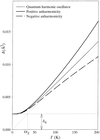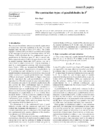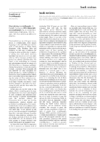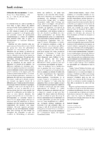issue contents
September 2000 issue

Cover illustration: Unit cell of a self-intersecting minimal surface with symmetry I432. The surface subdivides R3 into two congruent three-periodic mutually interpenetrating labyrinths with symmetry P4232. Lines of self-intersection are marked in red. See Koch [Acta Cryst. (2000), A56, 15-23].
research papers
A mean-field model describing the temperature evolution of anisotropic displacement parameters (ADP's) is presented. With this model, ADP's pertaining to different temperatures may be analysed for mutual consistency, for correlations of atomic displacements as well as for contributions from disorder and systematic error.
Anisotropic displacement parameters (ADP's) of C6D6 and OC(NH2)2 from neutron diffraction experiments in the temperature range 12–123 K are analysed with the mean-field model presented in the preceding paper. Some features of the molecular dynamics are derived from the multi-temperature ADP's and found to agree well with those from independent spectroscopic experiments.
A model for the anharmonic temperature evolution of anisotropic displacement parameters is developed and tested with X-ray and neutron diffraction data from hexamethylenetetramine measured between 15 and 298 K.
Download citation


Download citation


It is shown that structure solution and refinement of non-linear optically active molecular crystals is possible based on electron diffraction combined with quantum mechanics, packing-energy calculations and direct methods.
A new phasing procedure is described, able to solve the ab initio crystal structures of proteins with up to 2000 non-hydrogen atoms in the asymmetric unit.
It is shown that, even though the kinematical theory for electron diffraction is not rigorously accurate for transmission electron diffraction except for unrealistically thin samples, the statistical distribution of phases retains many kinematical characteristics.
Atomic scattering factors have been calculated for ionization by fast electrons from the K shell for elements in the range Z = 6 to 50 and from the L shell for Z = 20 to 60.
A general process to derive systematically the contraction types of parallelohedra is described. Then numbers of contraction types of parallelohedra in E5 are given for each of the 84 contraction families.
The paracrystalline and perturbed lattice models of disordered crystals, and their diffraction patterns, are compared in the one-dimensional case.
short communications
The dynamical theory of X-ray diffraction is applied to Bragg-surface diffraction. A solution for the boundary condition of this unusual three-beam diffraction is presented.
book reviews
Free 

Free 



 journal menu
journal menu































